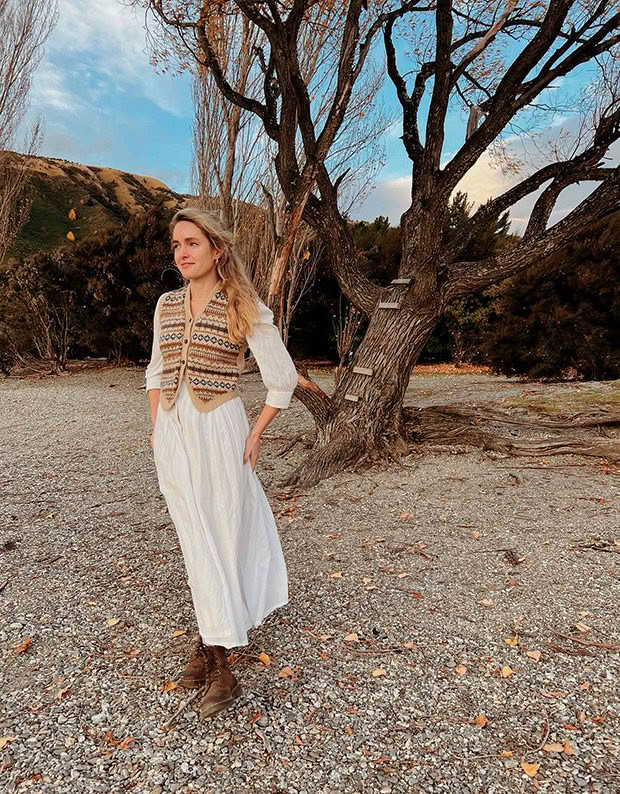A lifetime of vintage loving led Lydia Bishop to her dream second-hand fashion business

An obsession with pre-loved fashion has set serial thrift-er Lydia Bishop on her feet.
Words: Sarah Templeton
The slip of silk. Crisp cotton. Thick wools. Lydia Bishop runs her hands over racks of pre-loved fashion in a second-hand store, feeling the fibres under her fingers.
“As soon as I feel it, I’ll pull it out and look at it. I’m lucky because I have technical training in textiles, so I know exactly the hand feel that makes a piece jump out,” she says.
Lydia studied fashion design at Ara Institute in Christchurch and now uses her technical skills while on regular op-shop visits throughout Central Otago. The serial thrift-er undertakes thrifting missions to Wānaka, Alexandra, Cromwell and beyond to find gems.
Once something catches her eye, the devil is in the details. “I look for the seaming details, any marks or tears and am always on the lookout for the label, Made in New Zealand. Seeing that means it’s probably genuine vintage, excellent quality, worth buying and now rare.”
That’s because while Aotearoa’s second-hand marketplace and slow-fashion movement are slowly gaining momentum, they battle against the fast-fashion trend cycle. Mass-produced clothes fill clothing bins as fast as they’re released.
Seven years ago, thrifting became an outlet for Lydia when she and her fiancé Lukas Aebli moved from Auckland to Cromwell so that Lukas, a former landscaper, could pursue his dream role working in the Central Otago vineyards. (He’s now the operations manager at Peregrine.) As they found their feet in a new town, Lydia’s hours were filled by trawling op-shops while her viticulturist partner travelled between vineyards.
“I had zero friends, and my weekends were bleak with nobody to hang out with,” she says. “I had to preoccupy myself with something, and that’s how it began — because I had no friends!”
View this post on Instagram
She turned to a hobby she’s had since she was a child. “I’ve worn vintage for as long as I can remember,” she says. “And as I’m a third child, basically everything I owned growing up was a hand-me-down, with no stigma attached to wearing clothes that have already been worn.”
These days, she hardly ever buys new, instead opting for a wardrobe that’s probably 95 per cent vintage pieces found in op-shops and online. “If I ever buy something that’s not a vintage piece, it’ll be a piece by a local designer, and even then, I’ll probably just wait it out until I can get it on Trade Me. I’ve waited for two years in the past.”
Lydia now has a tight-knit circle of friends in Central Otago, especially since moving across the valley to Wānaka, and her passion for thrifting remains. With a closet only able to house so much, it’s evolved into her Instagram page, Picked By Lyds, begun as a way to show off her finds against the landscape. Lukas moonlights as her fashion photographer, and she now sells pieces picked up on thrifting missions around the region.
“I usually find the best pieces in Cromwell and Alexandra, where a lot of older residents go into rest homes and donate all their clothes. There’s lots of amazing true vintage in Central Otago, often of the most incredible quality.”
Her talent for restoration sees her washing cashmere in the bathtub, restoring linings and stitching on missing buttons. Among her most beloved finds are 100 per cent wool Harris Tweed coats and local alpaca wool jumpers. Parting with these prized finds can be painful.
“The piece I regret selling was a hand-knitted homespun cardigan that I thrifted about a year-and-a-half ago,” she says. “I sold it to a girl who loves it, but I still think about it most days. It was a thick, chunky knit that some lovely nana had slaved over.”
But for every ghost of cardigans past, there are treasures on hangers in her house, including a vintage Yves Saint-Laurent men’s blazer she calls her best-ever bargain. “Lukas wears it to every wedding we go to. It’s the most beautiful piece. It fits him like a glove, and it was $5. It would have retailed for thousands.
“So, I’m sad my best find wasn’t a piece for me,” she says. “But he benefits from it greatly.”
LYDIA’S TIPS FOR THRIFTING

1. Set aside plenty of time to shop. Diving deep into op-shops is time-consuming. “I usually spend an entire day thrifting. Take snacks.”
2. Rural locations are best. Bigger cities are often over-picked and overpriced. My best finds are always from smaller towns.
3. Have an idea of what you’re searching for. Create mood boards for the style of items you wish to source. That way, you’ll have some direction and won’t impulse-buy something you won’t wear.
4. Natural is always best. Synthetic fibres can be hard to avoid in vintage pieces, but natural fibres are always nicer to wear.
5. If it doesn’t fit right, don’t buy it. It’s tempting to purchase pieces with the thought of altering them in future, but will you get around to doing this?
6. Ask the staff. Find out when the shop is restocked and plan missions accordingly.
Love this story? Subscribe now!
 This article first appeared in NZ Life & Leisure Magazine.
This article first appeared in NZ Life & Leisure Magazine.
